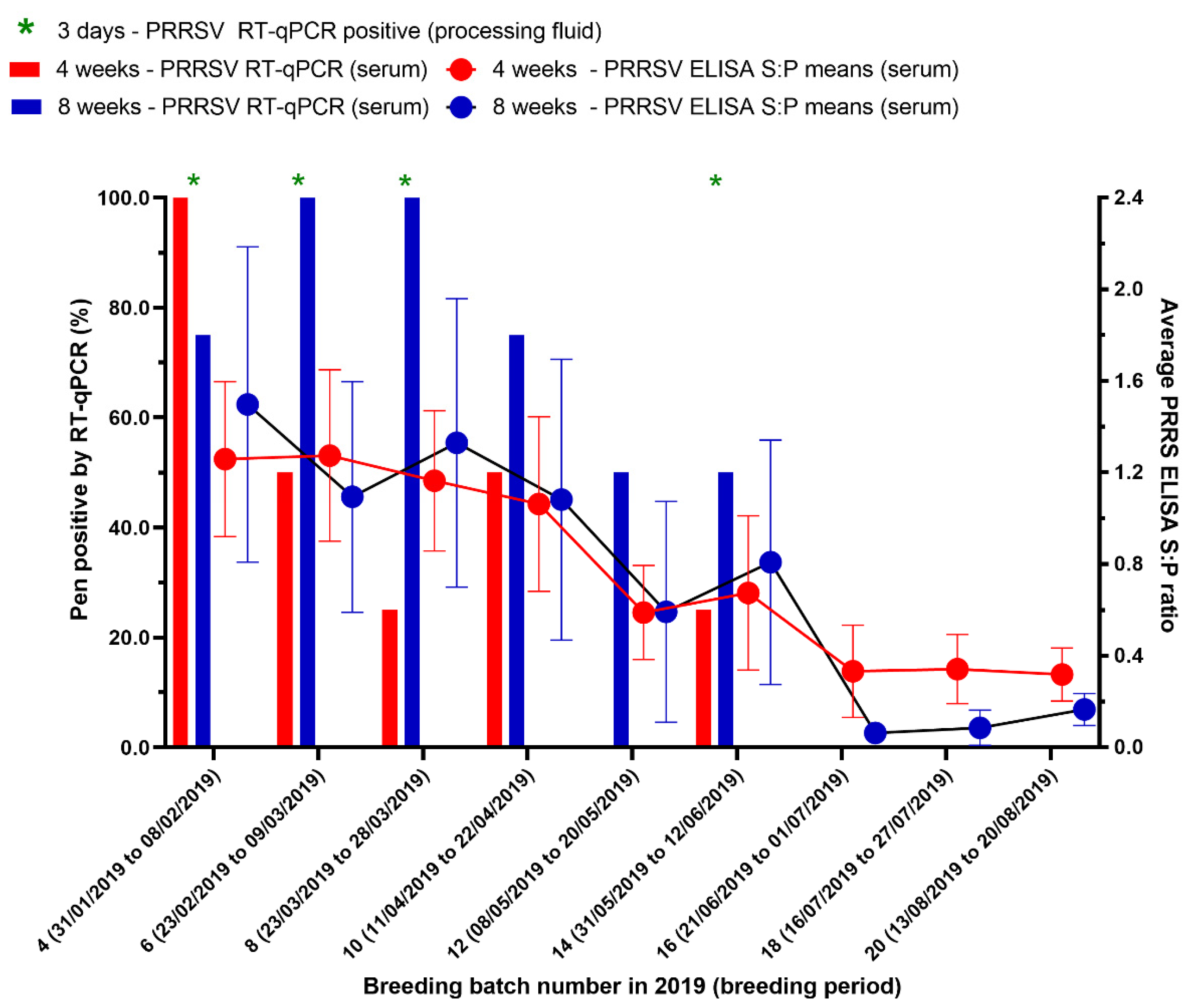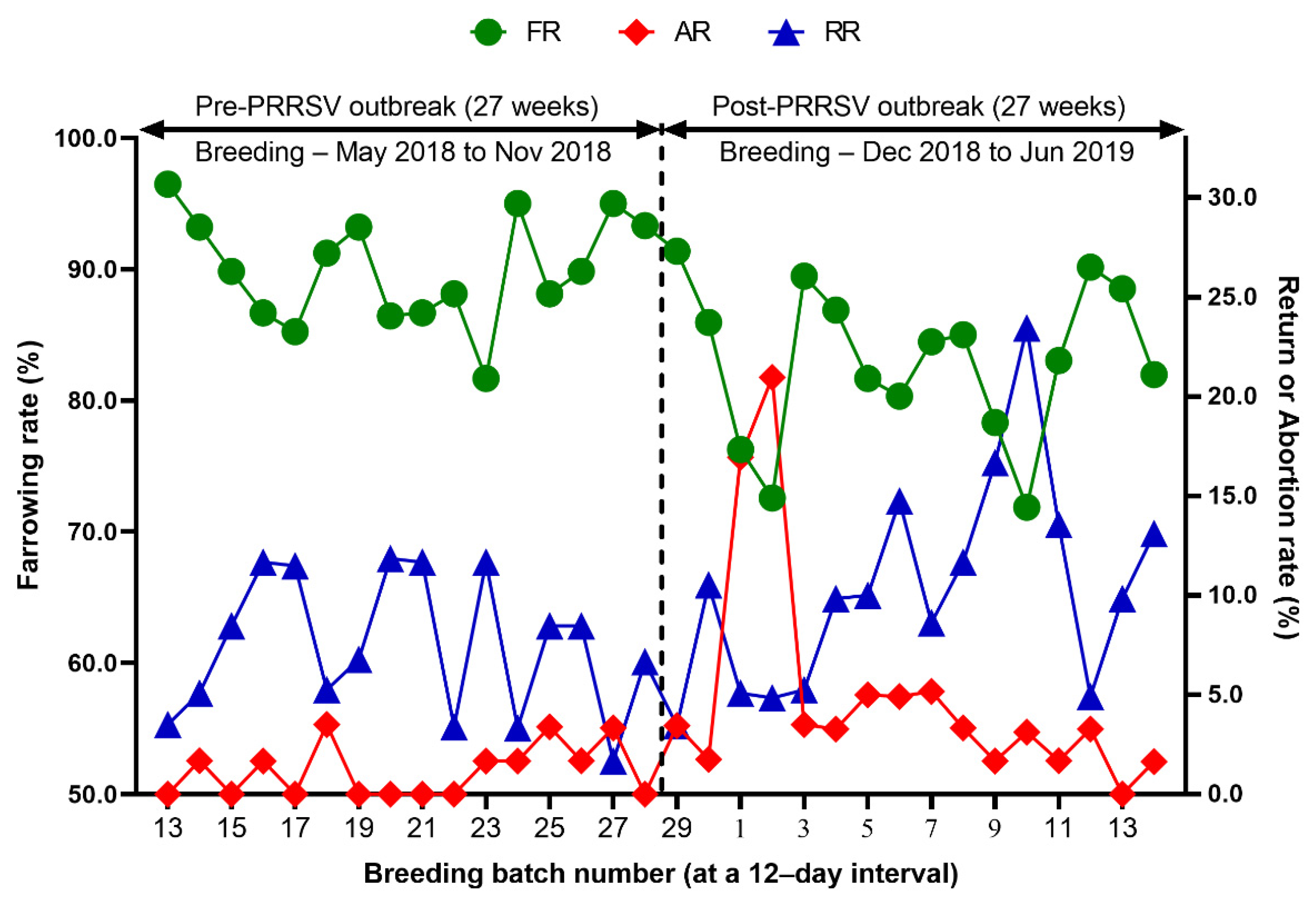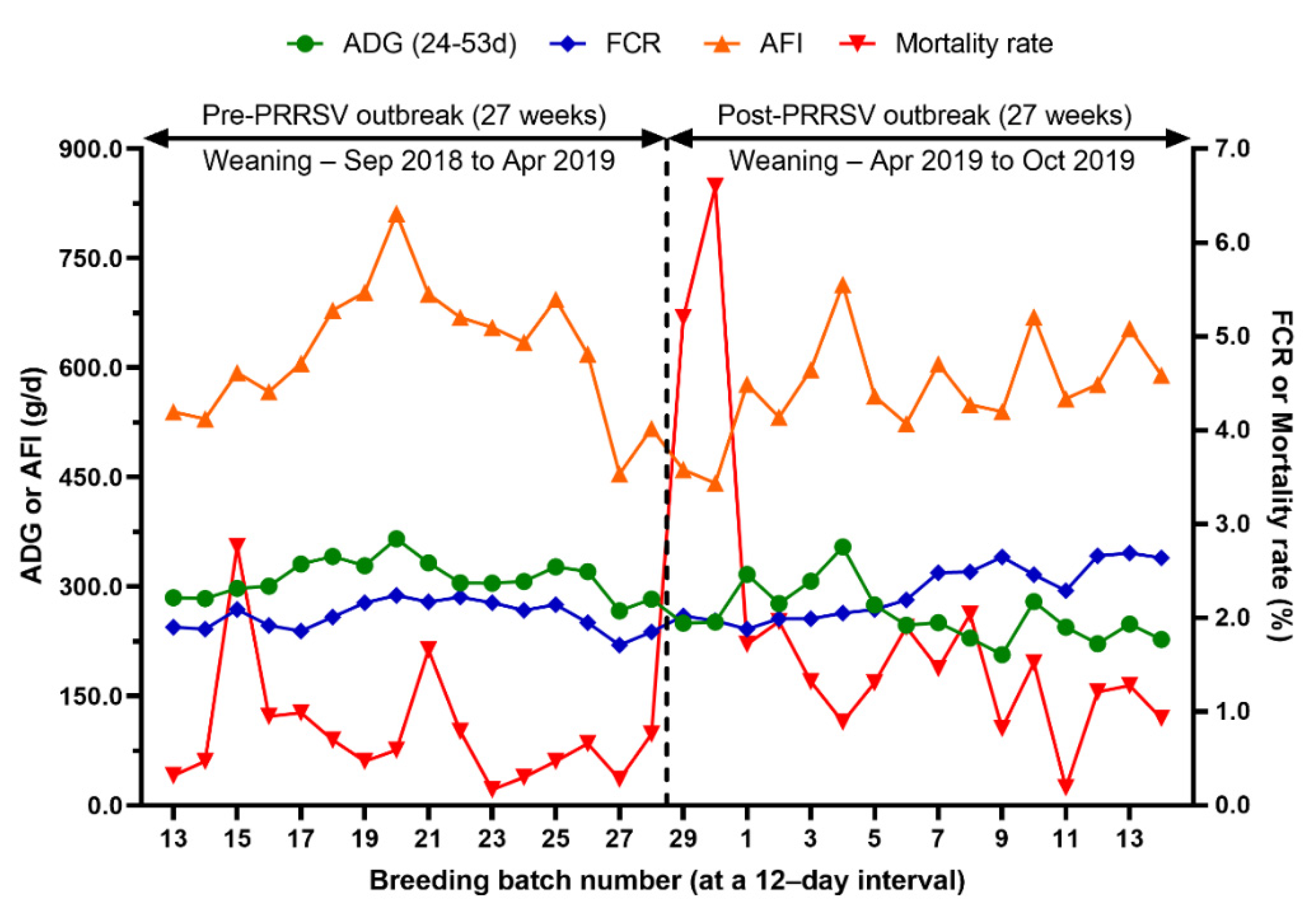Insight into the Economic Effects of a Severe Korean PRRSV1 Outbreak in a Farrow-to-Nursery Farm
Abstract
Simple Summary
Abstract
1. Introduction
2. Materials and Methods
2.1. Study Population and PRRSV Outbreak History
2.2. Genetic Characteristics of PRRSV
2.3. Assessment of the Production and Economic Impact
2.4. Statistical Analysis
3. Results
3.1. Production Impact of a PRRS Outbreak in the Breeding-Farrowing and Nursery Phases
3.2. Economic Impact of the PRRS Outbreak for the Breeding-Farrowing Phase on Gilts and Sows
3.3. Economic Impact of the PRRS Outbreak for the Growth Phase on Nursery Pigs
4. Discussion
5. Conclusions
Supplementary Materials
Author Contributions
Funding
Institutional Review Board Statement
Informed Consent Statement
Data Availability Statement
Acknowledgments
Conflicts of Interest
References
- Keffaber, K. Reproduction failure of unknown etiology. Am. Assoc. Swine Pract. Newsl. 1989, 1, 1–9. [Google Scholar]
- Neumann, E.J.; Kliebenstein, J.B.; Johnson, C.D.; Mabry, J.W.; Bush, E.J.; Seitzinger, A.H.; Green, A.L.; Zimmerman, J.J. Assessment of the economic impact of porcine reproductive and respiratory syndrome on swine production in the United States. J. Am. Vet. Med. Assoc. 2005, 227, 385–392. [Google Scholar] [CrossRef] [PubMed]
- Holtkamp, D.J.; Kliebenstein, J.B.; Neumann, E.; Zimmerman, J.J.; Rotto, H.; Yoder, T.K.; Wang, C.; Yeske, P.; Mowrer, C.L.; Haley, C.A. Assessment of the economic impact of porcine reproductive and respiratory syndrome virus on United States pork producers. J. Swine Health Prod. 2013, 21, 72. [Google Scholar]
- Kuhn, J.H.; Lauck, M.; Bailey, A.L.; Shchetinin, A.M.; Vishnevskaya, T.V.; Bao, Y.; Ng, T.F.; LeBreton, M.; Schneider, B.S.; Gillis, A.; et al. Reorganization and expansion of the nidoviral family Arteriviridae. Arch. Virol. 2016, 161, 755–768. [Google Scholar] [CrossRef] [PubMed]
- Brinton, M.A.; Gulyaeva, A.A.; Balasuriya, U.B.; Dunowska, M.; Faaberg, K.S.; Goldberg, T.; Leung, F.C.; Nauwynck, H.J.; Snijder, E.J.; Stadejek, T. ICTV virus taxonomy profile: Arteriviridae 2021. J. Gen. Virol. 2021, 102, 001632. [Google Scholar] [CrossRef]
- Kim, J.-Y.; Lee, S.-Y.; Sur, J.-H.; Lyoo, Y.S. Serological and genetic characterization of the European strain of the porcine reproductive and respiratory syndrome virus isolated in Korea. Korean J. Vet. Res. 2006, 46, 363–370. [Google Scholar]
- Nam, E.; Park, C.-K.; Kim, S.-H.; Joo, Y.-S.; Yeo, S.-G.; Lee, C. Complete genomic characterization of a European type 1 porcine reproductive and respiratory syndrome virus isolate in Korea. Arch. Virol. 2009, 154, 629–638. [Google Scholar] [CrossRef]
- Cha, S.-H.; Choi, E.-J.; Park, J.-H.; Yoon, S.-R.; Song, J.-Y.; Kwon, J.-H.; Song, H.-J.; Yoon, K.-J. Molecular characterization of recent Korean porcine reproductive and respiratory syndrome (PRRS) viruses and comparison to other Asian PRRS viruses. Vet. Microbiol. 2006, 117, 248–257. [Google Scholar] [CrossRef]
- Kwon, T.; Yoo, S.J.; Lee, D.-U.; Sunwoo, S.Y.; Sang, H.J.; Park, J.W.; Kim, M.-H.; Park, C.-K.; Lyoo, Y.S. Differential evolution of antigenic regions of porcine reproductive and respiratory syndrome virus 1 before and after vaccine introduction. Virus Res. 2019, 260, 12–19. [Google Scholar] [CrossRef]
- Kang, H.; Yu, J.E.; Shin, J.-E.; Kang, A.; Kim, W.-I.; Lee, C.; Lee, J.; Cho, I.-S.; Choe, S.-E.; Cha, S.-H. Geographic distribution and molecular analysis of porcine reproductive and respiratory syndrome viruses circulating in swine farms in the Republic of Korea between 2013 and 2016. BMC Vet. Res. 2018, 14, 160. [Google Scholar] [CrossRef]
- Kim, S.-H.; Roh, I.-S.; Choi, E.-J.; Lee, C.; Lee, C.-H.; Lee, K.-H.; Lee, K.-K.; Song, Y.-K.; Lee, O.-S.; Park, C.-K. A molecular analysis of European porcine reproductive and respiratory syndrome virus isolated in South Korea. Vet. Microbiol. 2010, 143, 394–400. [Google Scholar] [CrossRef] [PubMed]
- Kwon, T.; Yoo, S.J.; Sunwoo, S.Y.; Lee, D.-U.; Sang, H.J.; Park, J.W.; Park, C.-K.; Lyoo, Y.S. Independent evolution of porcine reproductive and respiratory syndrome virus 2 with genetic heterogeneity in antigenic regions of structural proteins in Korea. Arch. Virol. 2019, 164, 213–224. [Google Scholar] [CrossRef] [PubMed]
- Kim, H.; Nguyen, V.; Kim, I.; Park, J.; Park, S.; Rho, S.; Han, J.; Park, B. Epidemiologic and phylogenetic characteristics of porcine reproductive and respiratory syndrome viruses in conventional swine farms of Jeju Island as a candidate region for PRRSV eradication. Transbound. Emerg. Dis. 2012, 59, 62–71. [Google Scholar] [CrossRef]
- Kim, S.-C.; Jeong, C.-G.; Park, G.-S.; Park, J.-Y.; Jeoung, H.-Y.; Shin, G.-E.; Ko, M.-K.; Kim, S.-H.; Lee, K.-K.; Kim, W.-I. Temporal lineage dynamics of the ORF5 gene of porcine reproductive and respiratory syndrome virus in Korea in 2014–2019. Arch. Virol. 2021, 166, 2803–2815. [Google Scholar] [CrossRef] [PubMed]
- Brouwer, J.; Frankena, K.; De Jong, M.; Voets, R.; Dijkhuizen, A.; Verheijden, J.; Komijn, R. PRRS: Effect on herd performance after initial infection and risk analysis. Vet. Q. 1994, 16, 95–100. [Google Scholar] [CrossRef] [PubMed]
- Nieuwenhuis, N.; Duinhof, T.; Van Nes, A. Economic analysis of outbreaks of porcine reproductive and respiratory syndrome virus in nine sow herds. Vet. Rec. 2012, 170, 225. [Google Scholar] [CrossRef] [PubMed]
- Dee, S.; Joo, H.S.; Polson, D.; Marsh, W. Evaluation of the effects of nursery depopulation on the profitability of 34 pig farms. Vet. Rec. 1997, 140, 498–500. [Google Scholar] [CrossRef]
- Nathues, H.; Alarcon, P.; Rushton, J.; Jolie, R.; Fiebig, K.; Jimenez, M.; Geurts, V.; Nathues, C. Cost of porcine reproductive and respiratory syndrome virus at individual farm level—An economic disease model. Prev. Vet. Med. 2017, 142, 16–29. [Google Scholar] [CrossRef]
- Kristensen, C.S.; Christiansen, M.; Pedersen, K.; Larsen, L.E. Production losses five months after outbreak with a recombinant of two PRRSV vaccine strains in 13 Danish sow herds. Porc. Health Manag. 2020, 6, 26. [Google Scholar] [CrossRef]
- Choi, K.; Lee, J.; Park, C.; Jeong, J.; Chae, C. Comparison of the pathogenesis of single or dual infections with type 1 and type 2 porcine reproductive and respiratory syndrome virus. J. Comp. Pathol. 2015, 152, 317–324. [Google Scholar] [CrossRef]
- Karniychuk, U.U.; Geldhof, M.; Vanhee, M.; Van Doorsselaere, J.; Saveleva, T.A.; Nauwynck, H.J. Pathogenesis and antigenic characterization of a new East European subtype 3 porcine reproductive and respiratory syndrome virus isolate. BMC Vet. Res. 2010, 6, 30. [Google Scholar] [CrossRef] [PubMed]
- Dortmans, J.; Buter, G.; Dijkman, R.; Houben, M.; Duinhof, T. Molecular characterization of type 1 porcine reproductive and respiratory syndrome viruses (PRRSV) isolated in the Netherlands from 2014 to 2016. PLoS ONE 2019, 14, e0218481. [Google Scholar] [CrossRef] [PubMed]
- Martin-Valls, G.; Kvisgaard, L.K.; Tello, M.; Darwich, L.; Cortey, M.; Burgara-Estrella, A.; Hernandez, J.; Larsen, L.E.; Mateu, E. Analysis of ORF5 and full-length genome sequences of porcine reproductive and respiratory syndrome virus isolates of genotypes 1 and 2 retrieved worldwide provides evidence that recombination is a common phenomenon and may produce mosaic isolates. J. Virol. 2014, 88, 3170–3181. [Google Scholar] [CrossRef] [PubMed]
- Chen, N.; Liu, Q.; Qiao, M.; Deng, X.; Chen, X.; Sun, M. Whole genome characterization of a novel porcine reproductive and respiratory syndrome virus 1 isolate: Genetic evidence for recombination between Amervac vaccine and circulating strains in mainland China. Infect. Genet. Evol. 2017, 54, 308–313. [Google Scholar] [CrossRef]
- Frossard, J.-P.; Hughes, G.J.; Westcott, D.G.; Naidu, B.; Williamson, S.; Woodger, N.G.; Steinbach, F.; Drew, T.W. Porcine reproductive and respiratory syndrome virus: Genetic diversity of recent British isolates. Vet. Microbiol. 2013, 162, 507–518. [Google Scholar] [CrossRef]
- Marton, S.; Szalay, D.; Kecskeméti, S.; Forró, B.; Olasz, F.; Zádori, Z.; Szabó, I.; Molnár, T.; Bányai, K.; Bálint, Á. Coding-complete sequence of a vaccine-derived recombinant porcine reproductive and respiratory syndrome virus strain isolated in Hungary. Arch. Virol. 2019, 164, 2605–2608. [Google Scholar] [CrossRef]
- Kvisgaard, L.K.; Kristensen, C.S.; Ryt-Hansen, P.; Pedersen, K.; Stadejek, T.; Trebbien, R.; Andresen, L.O.; Larsen, L.E. A recombination between two Type 1 Porcine Reproductive and Respiratory Syndrome Virus (PRRSV-1) vaccine strains has caused severe outbreaks in Danish pigs. Transbound. Emerg. Dis. 2020, 67, 1786–1796. [Google Scholar] [CrossRef]
- Jeong, C.-G.; Nazki, S.; Kim, S.-C.; Khatun, A.; Noh, Y.-H.; Lee, D.-U.; Kang, S.C.; Seo, B.-J.; Yang, M.-S.; Lee, S.-I. Comparison of the pathogenicity of porcine reproductive and respiratory syndrome virus (PRRSV)-1 and PRRSV-2 in pregnant sows. Arch. Virol. 2022, 167, 425–439. [Google Scholar] [CrossRef]
- Shabir, N.; Khatun, A.; Nazki, S.; Gu, S.; Lee, S.-M.; Hur, T.-Y.; Yang, M.-S.; Kim, B.; Kim, W.-I. In vitro immune responses of porcine alveolar macrophages reflect host immune responses against porcine reproductive and respiratory syndrome viruses. BMC Vet. Res. 2018, 14, 1–13. [Google Scholar] [CrossRef]
- Kim, S.-C.; Moon, S.-H.; Jeong, C.-G.; Park, G.-S.; Park, J.-Y.; Jeoung, H.-Y.; Shin, G.-E.; Ko, M.-K.; Kim, S.-H.; Lee, K.-K. Whole-genome sequencing and genetic characteristics of representative porcine reproductive and respiratory syndrome virus (PRRSV) isolates in Korea. Virol. J. 2022, 19, 66. [Google Scholar] [CrossRef]
- Kumar, S.; Stecher, G.; Li, M.; Knyaz, C.; Tamura, K. MEGA X: Molecular Evolutionary Genetics Analysis across Computing Platforms. Mol. Biol. Evol. 2018, 35, 1547–1549. [Google Scholar] [CrossRef]
- Martin, D.P.; Murrell, B.; Golden, M.; Khoosal, A.; Muhire, B. RDP4: Detection and analysis of recombination patterns in virus genomes. Virus Evol. 2015, 1, vev003. [Google Scholar] [CrossRef] [PubMed]
- Lole, K.S.; Bollinger, R.C.; Paranjape, R.S.; Gadkari, D.; Kulkarni, S.S.; Novak, N.G.; Ingersoll, R.; Sheppard, H.W.; Ray, S.C. Full-length human immunodeficiency virus type 1 genomes from subtype C-infected seroconverters in India, with evidence of intersubtype recombination. J. Virol. 1999, 73, 152–160. [Google Scholar] [CrossRef] [PubMed]
- Díaz, I.; Gimeno, M.; Darwich, L.; Navarro, N.; Kuzemtseva, L.; López, S.; Galindo, I.; Segalés, J.; Martín, M.; Pujols, J. Characterization of homologous and heterologous adaptive immune responses in porcine reproductive and respiratory syndrome virus infection. Vet. Res. 2012, 43, 30. [Google Scholar] [CrossRef] [PubMed]
- Geldhof, M.F.; Vanhee, M.; Van Breedam, W.; Van Doorsselaere, J.; Karniychuk, U.U.; Nauwynck, H.J. Comparison of the efficacy of autogenous inactivated Porcine Reproductive and Respiratory Syndrome Virus (PRRSV) vaccines with that of commercial vaccines against homologous and heterologous challenges. BMC Vet. Res. 2012, 8, 182. [Google Scholar] [CrossRef]
- Polson, D.; Marsh, W.; Dial, G. Financial implications of mystery swine disease (MSD). In Proceedings of the Proc Livest Conserv Inst, 1990; pp. 8–28. [Google Scholar]
- Dykhuizen, A.; Jalvingh, A.; Bolder, F.; Stelwagen, J.; Schukken, Y. Determining the economic impact of the “new” pig disease. In Proceedings of the Seminar on PRRS, Brussel, Germany,, 1991; pp. 53–59. [Google Scholar]
- Vogel, K.; Kramer, M.; Leuffert, J.; Kramer, S. PRRS-epidemiological and economic analyses in Germany. In Proceedings of the Seminar on PRRS, Brussel, Germany, 1991; pp. 49–52. [Google Scholar]
- Lewis, C.; Torremorell, M.; Bishop, S. Effects of porcine reproductive and respiratory syndrome virus infection on the performance of commercial sows and gilts of different parities and genetic lines. J. Swine Health Prod. 2009, 17, 140–147. [Google Scholar]
- Pejsak, Z.; Stadejek, T.; Markowska-Daniel, I. Clinical signs and economic losses caused by porcine reproductive and respiratory syndrome virus in a large breeding farm. Vet. Microbiol. 1997, 55, 317–322. [Google Scholar] [CrossRef]
- Stadejek, T.; Podgorska, K.; Porowski, M.; Jabłoński, A.; Pejsak, Z. Linked outbreaks and control of porcine reproductive and respiratory syndrome and postweaning multisystemic wasting syndrome in a pig farm in Poland. Vet. Rec. 2011, 169, 441. [Google Scholar] [CrossRef]






| Reproductive Performance | Pre-Outbreak | Post-Outbreak | Difference | p-Value |
|---|---|---|---|---|
| Number of matings (average/batch) | 948 (59.3) | 959 (59.9) | 11 | 0.2126 |
| Number of farrowings (average/batch) | 853 (53.3) | 795 (49.7) | −58 | 0.0006 |
| Parity | 4.0 | 4.2 | 0.2 | 0.1063 |
| Gestation length (days) | 115.1 ± 1.2 | 115.3 ± 1.5 | 0.2 | <0.0001 |
| Early parturition rate (<114 days, %) | 6.5 | 22.3 | 15.8 | <0.0001 |
| Farrowing rate (%) (FR) | 90.0 | 82.9 | −7.1 | <0.0001 |
| Abortion rate (%(AR) | 1.2 | 5.0 | 3.9 | <0.0001 |
| Return rate (%) (RR) | 7.5 | 10.4 | 2.9 | 0.0250 |
| Weaning to estrus intervals (days) (WEI) | 4.6 ± 2.3 | 6.5 ± 6.3 | 1.9 | <0.0001 |
| The percentage of sows mated within 7 days after weaning (%) | 96.5 | 88.0 | −8.5 | <0.0001 |
| Total piglets born per litter (TB) | 14.5 ± 4.0 | 13.3 ± 4.4 | −1.2 | <0.0001 |
| Piglets born alive per litter (BA) | 13.6 ± 3.7 | 11.4 ± 4.2 | −2.2 | <0.0001 |
| Stillborn piglets per litter (SB) | 0.6 ± 1.0 | 1.0 ± 1.9 | 0.4 | <0.0001 |
| Mummified fetuses per litter (MM) | 0.3 ± 0.7 | 0.9 ± 2.2 | 0.6 | <0.0001 |
| Weaned piglets per litter (WP) | 11.7 ± 2.0 | 9.0 ± 3.5 | −2.7 | <0.0001 |
| Lactation length (days) | 24.0 ± 2.4 | 24.0 ± 2.3 | 0.0 | 0.4077 |
| Growth Performance | Pre-Outbreak | Post-Outbreak | Difference | p-Value |
|---|---|---|---|---|
| Pre-weaning mortality (%) | 13.8 | 21.3 | 7.4 | <0.0001 |
| Body weight at weaning (kg) | 6.7 ± 0.7 | 5.8 ± 0.8 | −0.9 | 0.0015 |
| Nursery period (24–53 days) | ||||
| Body weight at 53d (kg) | 16.3 ± 1.5 | 13.7 ± 1.8 | −2.6 | <0.0001 |
| ADG (g/d) | 311.2 ± 25.8 | 261.7 ± 38.6 | −49.5 | 0.0002 |
| AFI (g/d) | 623.3 ± 89.1 | 571.8 ± 70.2 | −51.5 | 0.0795 |
| FCR | 2.02 ± 0.16 | 2.28 ± 0.29 | 0.26 | 0.0036 |
| Mortality rate (%) | 0.8 | 1.7 | 0.9 | <0.0001 |
| Nursery period (24–77 days) | ||||
| Body weight at 77d (kg) | 29.5 ± 1.0 | 25.3 ± 1.9 | −4.2 | <0.0001 |
| ADG (g/d) | 421.9 ± 19.5 | 352.1 ± 31.0 | −69.8 | <0.0001 |
| Mortality rate (%) | 2.1 | 4.9 | 2.8 | <0.0001 |
| Variable | Value |
|---|---|
| Reduced number of weaned pigs/mated female | |
| Difference in weaned pigs/mated female | 3.1 |
| Value of weaned pig/kg | KRW 5053 (USD 4.2) |
| Reduced revenue/mated female | KRW 90,860 (USD 75.7) |
| Additional feed consumption/mated female | |
| Feed price/kg | KRW 425 (USD0.4) |
| Feed intake from weaning to first service | 4.0 kg/day |
| Feed intake from first service to return-to-estrus or abortion | 2.5 kg/day |
| Delayed weaning to estrus intervals | 1.9 days |
| Increased feed cost/mated female | KRW 7568 (USD6.3) |
| Wasted semen/mated female | |
| Increased insemination cost/mated female | KRW 950 (USD 0.8) |
| Total cost/mated female | KRW 99,378 (USD 82.8) |
| Variable | Value |
|---|---|
| Cost of increased mortality rate | |
| Increased death loss | 2.83% |
| Value of a weaned pig | KRW 29,449 (USD 24.5) |
| Cost of death loss/pig | KRW 833 (USD 0.69) |
| Adjusted cost of death loss | KRW 857 † (USD 0.71) |
| Cost of reduced weaning weight and feed efficiency | |
| Feed price/kg | KRW 430 (USD 0.4) |
| Difference in total feed intake to reach 30kg/pig | 8.13 kg |
| Increased feed cost/pig | KRW 3497 (USD 2.9) |
| Cost of reduced weaning weight and average daily gain | |
| Facility cost/day [2] | KRW 120 (USD 0.1) |
| Difference in pig-rearing period to reach 30kg/pig | 13.5 days |
| Increased facility cost/pig | KRW 1620 (USD 1.3) |
| Increased fixed and non-feed variable costs | |
| Labor cost/pig | KRW 1061 (USD 0.9) |
| Building and facility cost/pig | KRW 458 (USD 0.4) |
| Insurance and tax | KRW 256 (USD 0.2) |
| Water, power, fuel and transport cost/pig | KRW 298 (USD 0.2) |
| Veterinary and medicine cost/pig | KRW 314 (USD 0.3) |
| Excretion disposal cost/pig | KRW 517 (USD 0.4) |
| Interest and miscellaneous materials cost/pig | KRW 91 (USD 0.1) |
| Total increased cost/pig | KRW 8968 (USD 7.5) |
Publisher’s Note: MDPI stays neutral with regard to jurisdictional claims in published maps and institutional affiliations. |
© 2022 by the authors. Licensee MDPI, Basel, Switzerland. This article is an open access article distributed under the terms and conditions of the Creative Commons Attribution (CC BY) license (https://creativecommons.org/licenses/by/4.0/).
Share and Cite
Kim, J.-H.; Kim, S.-C.; Kim, H.-J.; Jeong, C.-G.; Park, G.-S.; Choi, J.-S.; Kim, W.-I. Insight into the Economic Effects of a Severe Korean PRRSV1 Outbreak in a Farrow-to-Nursery Farm. Animals 2022, 12, 3024. https://doi.org/10.3390/ani12213024
Kim J-H, Kim S-C, Kim H-J, Jeong C-G, Park G-S, Choi J-S, Kim W-I. Insight into the Economic Effects of a Severe Korean PRRSV1 Outbreak in a Farrow-to-Nursery Farm. Animals. 2022; 12(21):3024. https://doi.org/10.3390/ani12213024
Chicago/Turabian StyleKim, Jung-Hee, Seung-Chai Kim, Hwan-Ju Kim, Chang-Gi Jeong, Gyeong-Seo Park, Jong-San Choi, and Won-Il Kim. 2022. "Insight into the Economic Effects of a Severe Korean PRRSV1 Outbreak in a Farrow-to-Nursery Farm" Animals 12, no. 21: 3024. https://doi.org/10.3390/ani12213024
APA StyleKim, J.-H., Kim, S.-C., Kim, H.-J., Jeong, C.-G., Park, G.-S., Choi, J.-S., & Kim, W.-I. (2022). Insight into the Economic Effects of a Severe Korean PRRSV1 Outbreak in a Farrow-to-Nursery Farm. Animals, 12(21), 3024. https://doi.org/10.3390/ani12213024






